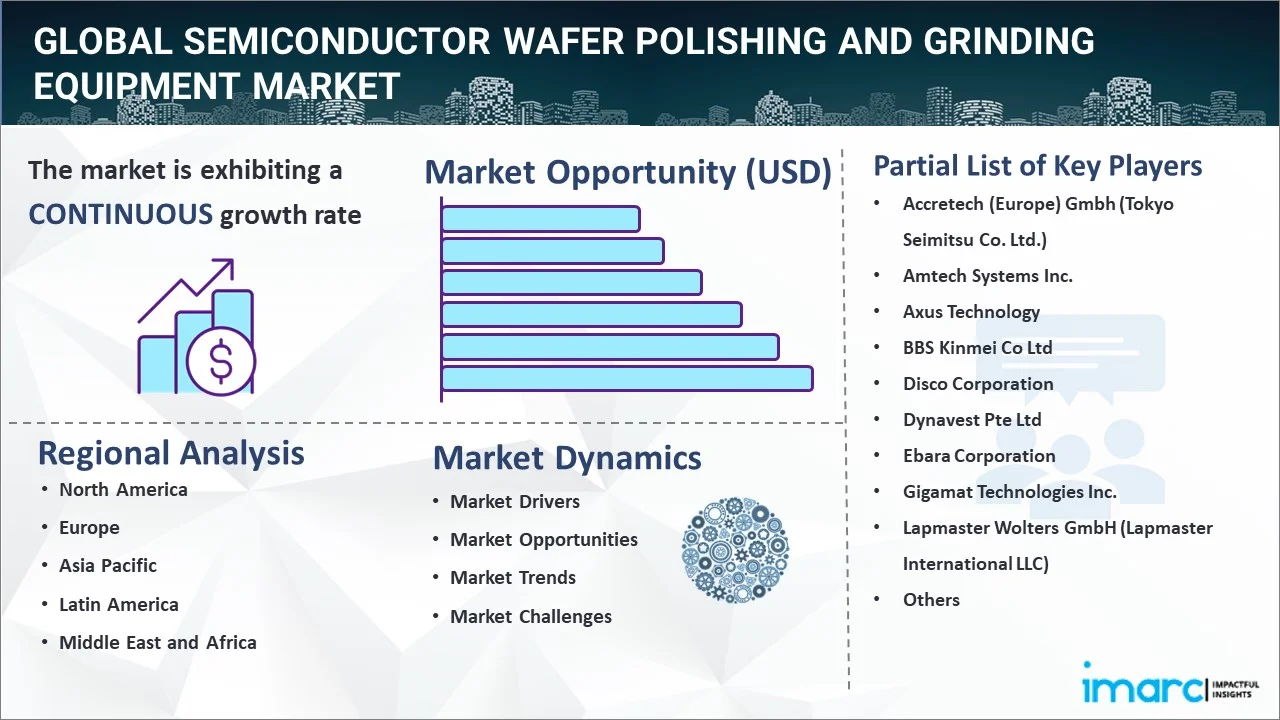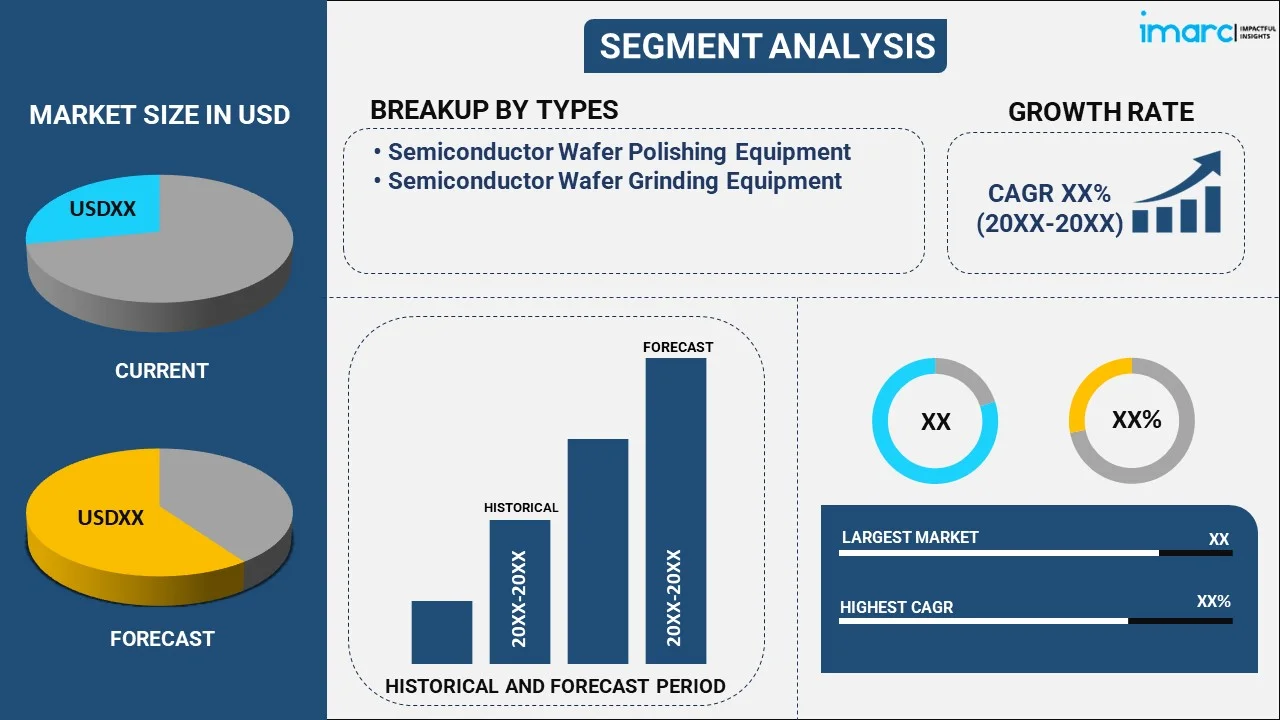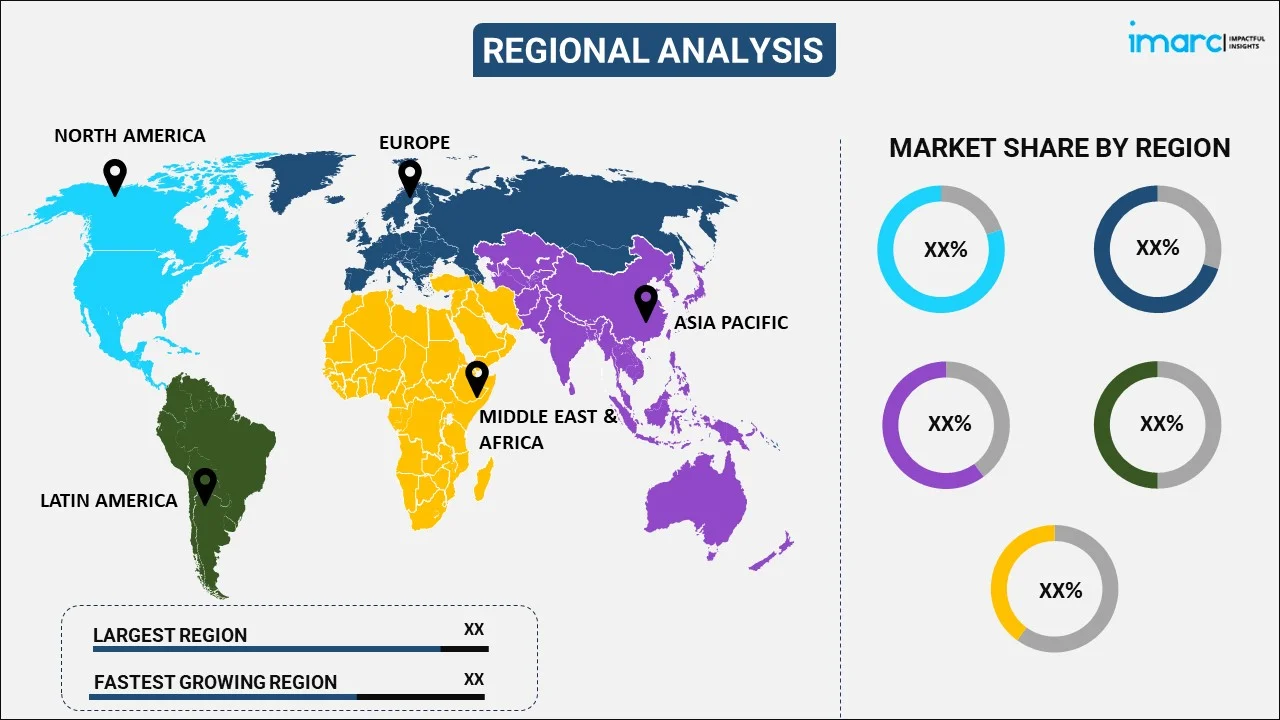
Semiconductor Wafer Polishing and Grinding Equipment Market Report by Type (Semiconductor Wafer Polishing Equipment, Semiconductor Wafer Grinding Equipment), End User (Foundries, Memory Manufacturers, IDMs, and Others), and Region 2025-2033
Market Overview:
The global semiconductor wafer polishing and grinding equipment market size reached USD 450.7 Million in 2024. Looking forward, IMARC Group expects the market to reach USD 671.8 Million by 2033, exhibiting a growth rate (CAGR) of 4.31% during 2025-2033. The rising demand for consumer electronics like smartphones, laptops, and tablets, increasing adoption of electric vehicles (EVs) on account of changing lifestyles of individuals, expansion of data centers, and technological advancements are propelling the market growth.
|
Report Attribute
|
Key Statistics
|
|---|---|
|
Base Year
|
2024
|
|
Forecast Years
|
2025-2033
|
|
Historical Years
|
2019-2024
|
|
Market Size in 2024
|
USD 450.7 Million |
|
Market Forecast in 2033
|
USD 671.8 Million |
| Market Growth Rate (2025-2033) | 4.31% |
Polishing and grinding equipment refer to advanced, indispensable components generally used while fabricating semiconductor wafers. They involve deposition, lithography, Ion implant, etching, and cleaning as some of the standard methods performed with the assistance of metallographic tools, disc finishing, and lapping machines. Semiconductor wafer polishing and grinding equipment aid in removing unwarranted material from a film and thinning and refining the product while ensuring a smooth and damage-free surface. On account of these properties, they are extensively utilized by foundries and memory manufacturers for composing integrated circuits.

Semiconductor Wafer Polishing and Grinding Equipment Market Trends:
Increasing Demand for Consumer Electronics
The growing adoption of consumer electronics, such as smartphones, laptops, and wearables, is offering a favorable semiconductor wafer polishing and grinding equipment market outlook. People are constantly seeking more powerful, compact, and energy-efficient devices, which require advanced semiconductors to meet performance demands. They are purchasing consumer electronics owing to their changing lifestyles. These devices make their difficult and numerous task easier while saving time. To achieve this, manufacturers rely on ultra-thin and smooth wafers, made possible through precise grinding and polishing processes. As electronics become smaller, the tolerances for imperfections in wafers tighten, making high-quality surface processing essential. In line with this, the increasing number of smart devices is catalyzing the semiconductor wafer polishing and grinding equipment market demand. Furthermore, the growing production of next-gen electronics requires the need for wafer surface refinement to optimize semiconductor performance.
Advancements in Semiconductor Technology
The continuous advancement in semiconductor technology, especially in areas like artificial intelligence (AI), fifth generation (5G), and the Internet of Things (IoT), is supporting the market growth. These cutting-edge applications require semiconductors with higher performance, lower power consumption, and smaller sizes, which can only be achieved by manufacturing ultra-smooth and defect-free wafers. New technologies like system-on-chip (SoC) designs and smaller node architectures need extremely precise wafer thickness and surface quality to ensure proper electrical performance, which is leading to a positive semiconductor wafer polishing and grinding equipment market scope. Advanced semiconductor technologies also involve complex multilayer structures and three dimensional (3D) stacking, which necessitate wafer thinning and polishing to achieve the necessary flatness and planarity. This increasing complexity in semiconductor designs directly impacts the demand for high-precision grinding and polishing equipment to meet the stringent quality standards required for modern electronic devices.
Growth in Automotive Electronics
The expanding use of electronics in vehicles, particularly with the rise of electric vehicles (EVs), autonomous driving technologies, and advanced driver-assistance systems (ADAS), is bolstering the semiconductor wafer polishing and grinding equipment market growth. In addition to this, modern automobiles rely heavily on semiconductors for critical functions like navigation, safety systems, battery management, and infotainment. As the automotive industry shifts towards electrification and intelligent driving systems, the demand for high-performance, durable, and efficient semiconductor components increases. Automotive semiconductors often need to meet stringent reliability and thermal stability standards, which require high-quality wafer surfaces produced through polishing and grinding. Apart from this, the growing need for lightweight and energy-efficient automotive designs is offering a favorable semiconductor wafer polishing and grinding equipment market forecast.
Semiconductor Wafer Polishing and Grinding Equipment Market Segmentation:
IMARC Group provides an analysis of the key trends in each segment of the global semiconductor wafer polishing and grinding equipment market report, along with forecasts at the global, regional and country levels from 2025-2033. Our report has categorized the market based on type and end user.
Breakup by Type:

- Semiconductor Wafer Polishing Equipment
- Semiconductor Wafer Grinding Equipment
Breakup by End User:
- Foundries
- Memory Manufacturers
- IDMs
- Others
Breakup by Region:

- North America
- United States
- Canada
- Asia-Pacific
- China
- Japan
- India
- South Korea
- Australia
- Indonesia
- Others
- Europe
- Germany
- France
- United Kingdom
- Italy
- Spain
- Russia
- Others
- Latin America
- Brazil
- Mexico
- Others
- Middle East and Africa
Competitive Landscape:
The competitive landscape of the industry has also been examined along with the profiles of the key players being Accretech (Europe) Gmbh (Tokyo Seimitsu Co. Ltd.), Amtech Systems Inc., Axus Technology, BBS Kinmei Co Ltd, Disco Corporation, Dynavest Pte Ltd, Ebara Corporation, Gigamat Technologies Inc., Lapmaster Wolters GmbH (Lapmaster International LLC), Logitech Ltd., Okamoto Machine Tool Works Ltd and Revasum Inc.
Semiconductor Wafer Polishing and Grinding Equipment Market Recent Developments:
- 31 March 2023: DISCO Corporation, a semiconductor manufacturing equipment manufacturer developed DFD6342, a fully automatic dicing saw that supports φ8-inch wafers. DFD6342 is the newer model of DFD6341, and it covers both the cutting and grooving processes for a wide range of materials used for semiconductor wafers, semiconductor packaging, and electronic components.
Report Coverage:
| Report Features | Details |
|---|---|
| Base Year of the Analysis | 2024 |
| Historical Period | 2019-2024 |
| Forecast Period | 2025-2033 |
| Units | Million USD |
| Segment Coverage | Type, End User, Region |
| Region Covered | Asia Pacific, Europe, North America, Latin America, Middle East and Africa |
| Countries Covered | United States, Canada, Germany, France, United Kingdom, Italy, Spain, Russia, China, Japan, India, South Korea, Australia, Indonesia, Brazil, Mexico |
| Companies Covered | Accretech (Europe) Gmbh (Tokyo Seimitsu Co. Ltd.), Amtech Systems Inc., Axus Technology, BBS Kinmei Co Ltd, Disco Corporation, Dynavest Pte Ltd, Ebara Corporation, Gigamat Technologies Inc., Lapmaster Wolters GmbH (Lapmaster International LLC), Logitech Ltd., Okamoto Machine Tool Works Ltd, Revasum Inc. |
| Customization Scope | 10% Free Customization |
| Post-Sale Analyst Support | 10-12 Weeks |
| Delivery Format | PDF and Excel through Email (We can also provide the editable version of the report in PPT/Word format on special request) |
Key Questions Answered in This Report:
- How has the global semiconductor wafer polishing and grinding equipment market performed so far and how will it perform in the coming years?
- What has been the impact of COVID-19 on the global semiconductor wafer polishing and grinding equipment market?
- What are the key regional markets?
- What is the breakup of the market based on the type?
- What is the breakup of the market based on the end user?
- What are the various stages in the value chain of the industry?
- What are the key driving factors and challenges in the industry?
- What is the structure of the global semiconductor wafer polishing and grinding equipment market and who are the key players?
- What is the degree of competition in the industry?
Need more help?
- Speak to our experienced analysts for insights on the current market scenarios.
- Include additional segments and countries to customize the report as per your requirement.
- Gain an unparalleled competitive advantage in your domain by understanding how to utilize the report and positively impacting your operations and revenue.
- For further assistance, please connect with our analysts.
 Inquire Before Buying
Inquire Before Buying
 Speak to an Analyst
Speak to an Analyst
 Request Brochure
Request Brochure
 Request Customization
Request Customization




.webp)




.webp)












